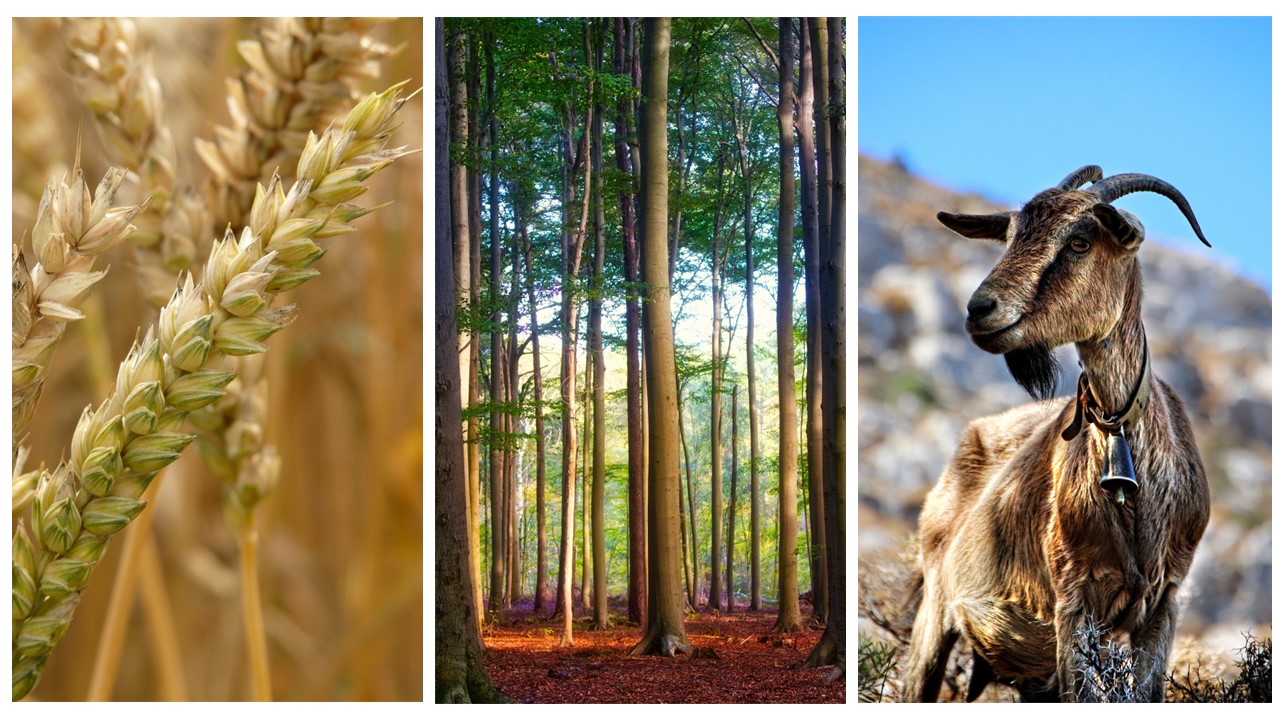European genetic resources conservation in a rapidly changing world: three existential challenges for the crop, forest and animal domains in the 21st century
Main Article Content
Abstract
Even though genetic resources represent a fundamental reservoir of options to achieve sustainable development goals in a changing world, they are overlooked in the policy agenda and severely threatened. The conservation of genetic resources relies on complementary in situ and ex situ approaches appropriately designed for each type of organism. Environmental and socioeconomic changes raise new challenges and opportunities for sustainable use and conservation of genetic resources.
Aiming at a more integrated and adaptive approach, European scientists and genetic resources managers with long experience in the agricultural crop, animal and forestry domains joined their expertise to address three critical challenges: (1) how to adapt genetic resources conservation strategies to climate change, (2) how to promote in situ conservation strategies and (3) how can genetic resources conservation contribute to and benefit from agroecological systems. We present here 31 evidence-based statements and 88 key recommendations elaborated around these questions for policymakers, conservation actors and the scientific community.
We anticipate that stakeholders in other genetic resources domains and biodiversity conservation actors across the globe will have interest in these crosscutting and multi-actor recommendations, which support several biodiversity conservation policies and practices.
Article Details

This work is licensed under a Creative Commons Attribution 4.0 International License.
Authors retain copyright of the articles published in Genetic Resources and grant the journal right of first publication with open access. All articles published in Genetic Resource are licensed under Creative Commons Attribution 4.0 International License (CC BY 4.0) that allows others to download, share and adapt the work for commercial and non-commercial purposes as long as proper attribution to the original article is given. Genetic Resources permits and encourages authors to post items submitted to the journal (including the publisher's final layout) on personal websites or institutional repositories after acceptance and/or publication, while providing bibliographic details that credit their publication in Genetic Resources.
Brehm, J Magos et al. (2017). Interactive Toolkit for Crop Wild Relative Conservation Planning version 1.0. University of Birmingham, Birmingham, UK and Bioversity International, Rome, Italy. URL: http://www.cropwildrelatives.org/conservation-toolkit/.
CBD (1992). Text of the Convention on Biological Diversity. United Nations. URL: https://www.cbd.int/convention/text/.
CBD (2020). Global Biodiversity Outlook 5. Montreal, Canada: Convention on Biological Diversity, p. 208. URL: https://www.cbd.int/gbo5.
CBD (2022). Kunming-Montreal Global Biodiversity Framework. CBD/COP/DEC/15/4. Montreal, Canada: Convention on Biological Diversity. URL: https://www.cbd.int/doc/decisions/cop-15/cop-15-dec-04-en.pdf.
Chable, V et al. (2020). “Embedding Cultivated Diversity in Society for Agro-Ecological Transition”. Sustainability 12, pp. 784–784. DOI: https://doi.org/10.3390/su12030784. DOI: https://doi.org/10.3390/su12030784
ECPGR (2021). Plant Genetic Resources Strategy for Europe. Rome, Italy: European Cooperative Programme for Plant Genetic Resources, p. 71. URL: https://www.ecpgr.cgiar.org/fileadmin/bioversity/publications/pdfs/PGR_STRATEGY_LP_22_Nov_revised.pdf.
Ellstrand, N C and L H Rieseberg (2016). “When gene flow really matters: gene flow in applied evolutionary biology”. Evolutionary Applications 9, pp. 833–836. DOI: https://doi.org/10.1111/eva.12402. DOI: https://doi.org/10.1111/eva.12402
ERFP (2021). Animal Genetic Resources Strategy For Europe, p. 34. URL: https://www.animalgeneticresources.net/wp-content/uploads/2022/03/Final_AnGR-Strategy-_022022.pdf.
EUFORGEN (2021). Forest Genetic Resources Strategy For Europe. Barcelona, Spain: European Forest Institute, p. 64. URL: http://www.euforgen.org/FgRStrategy4Europe.
FAO (2015). Coping with climate change - the roles of genetic resources for food and agriculture. Rome, Italy: Food and Agriculture Organization, p. 110. URL: https://www.fao.org/3/i3866e/i3866e.pdf.
FAO (2019). The State of the World’s Biodiversity for Food and Agriculture. Ed. by J Bélanger and D Pilling. Rome, Italy: FAO Commission on Genetic Resources for Food and Agriculture. URL: https://www.fao.org/3/CA3129EN/CA3129EN.pdf.
Frankel, O H and E Bennett (1970). Genetic Resources in Plants – Their Exploration and Conservation, International Biological Programme, Handbook II. Oxford: Blackwell, p. 554.
GenRes Bridge Project Consortium, ECPGR, ERFP and EUFORGEN (2021). Genetic Resources Strategy for Europe. URL: http://www.genresbridge.eu/GRS4E.
Grau, R, T Kuemmerle, and L Macchi (2013). “Beyond ‘land sparing versus land sharing’: environmental heterogeneity, globalization and the balance between agricultural production and nature conservation”. Current Opinion in Environmental Sustainability 5, pp. 477–483. DOI: https://doi.org/10.1016/j.cosust.2013.06.001. DOI: https://doi.org/10.1016/j.cosust.2013.06.001
Haines-Young, R and M B Potschin (2018). Common International Classification of Ecosystem Services (CICES) V5.1 and Guidance on the Application of the Revised Structure. URL: https://cices.eu/content/uploads/sites/8/2018/01/Guidance-V51-01012018.pdf. DOI: https://doi.org/10.3897/oneeco.3.e27108
Hoban, S, M Bruford, et al. (2020). “Genetic diversity targets and indicators in the CBD post-2020 Global Biodiversity Framework must be improved”. Biological Conservation 248(108654). DOI: https://doi.org/10.1016/j.biocon.2020.108654. DOI: https://doi.org/10.1016/j.biocon.2020.108654
Hoban, S, F I Archer, et al. (2022). “Global genetic diversity status and trends: towards a suite of Essential Biodiversity Variables (EBVs) for genetic composition”. Biological Reviews 97, pp. 1511–1538. DOI: https://doi.org/10.1111/brv.12852. DOI: https://doi.org/10.1111/brv.12852
IPBES (2019). Global assessment report of the Intergovernmental Science-Policy Platform on Biodiversity and Ecosystem Services. Ed. by E S Brondízio et al. URL: https://ipbes.net/global-assessment.
IPCC (2019). Climate Change and Land: an IPCC special report on climate change, desertification, land degradation, sustainable land management, food security, and greenhouse gas fluxes in terrestrial ecosystems. Ed. by P R Shukla et al., p. 864. URL: https://www.ipcc.ch/site/assets/uploads/2019/11/SRCCL-Full-Report-Compiled-191128.pdf.
Iriondo, J M et al. (2021). Crop Wild Relative Population Management Guidelines. Farmer’s Pride: Networking, partnerships and tools to enhance in situ conservation of European plant genetic resources. URL: https://more.bham.ac.uk/farmerspride/wp-content/uploads/sites/19/2021/07/Crop_Wild_Relative_Population_Management_Guidelines.pdf.
Koskela, J, A Buck, and Teissier Du (2007). Climate change and forest genetic diversity: Implications for sustainable forest management in Europe. Rome, Italy: Bioversity International, p. 111. URL: https://www.euforgen.org/fileadmin/bioversity/publications/pdfs/1216.pdf.
Maxted, N, S Kell, and J Magos Brehm (2015). National Level Conservation and Use of Landraces Draft Technical Guidelines. Vol. 14. Rome, Italy: Food and Agriculture Organization of the United Nations. URL: http://www.fao.org/3/a-mm564e.pdf.
Pozo, R A et al. (2021). “Reconciling livestock production and wild herbivore conservation: challenges and opportunities”. Trends in Ecology and Evolution 36, pp. 750–761. DOI: https://doi.org/10.1016/j.tree.2021.05.002. DOI: https://doi.org/10.1016/j.tree.2021.05.002







 This journal has been conceived as part of the
This journal has been conceived as part of the